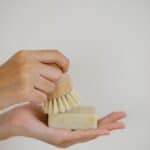If you’re looking for the best beginner’s guide to choosing the right soap making supplies, you’re at the right place. But let’s start with the basics. What are soaps?
Soaps are simply a product of a chemical reaction in which fats/oils react with alkali or lye. This process is called saponification and requires heat. Apart from these two basic ingredients, you can add your favorite essential oils, fragrances, and chosen colorants to make Body Shop-like scented soaps or bath bombs at home.

What are the essential soap-making supplies you will need?
- A digital scale is a must-have in your soap making kit to weigh your ingredients. Make sure the scale you purchase has a 5-pound capacity and can weigh in tenths of an ounce. The amount of lye used plays a great role in the success of your end product. Remember that the right amount of ingredients will get you your desired homemade soap. Otherwise, you will be wasting your resources if you do not measure out the oils and lye correctly.
- A warming pot to allow the base oils and lye to fuse. It is advisable to use a stainless steel pot with enamel finishing. Avoid using aluminum pans and non-stick pans, which react to halt the process.
- Hand blender to mix the ingredients easily. Make sure you keep this hand blender solely for making soaps and not your sauces. When making handmade soap, blending by hand is not an option; you cannot mix the soap by hand. That too for hours.
- Heavy-duty plastic utensils and spoons (preferably silicone material) for containing and mixing lye. If you’re wondering why you would need a heavy plastic container or why not use glass containers in soap making supplies? This is because lye can make glass weak at certain points exposing it to breakage.
- A thermometer to measure the temperature of lye solution. There is a huge variety of thermometers available, but it depends on the soap-making process which one will suit you. To save yourself from washing the thermometer again and again during the process, buy a digital thermometer. I have used the simple cooking thermometer, and it works just fine.
- Baking paper or greased paper for lining the mold.
- And finally, a sharp knife to divide your soap into pieces.
Safety equipment:
What you must not forget are goggles and rubber gloves to avoid any hazardous material getting in your eyes.
Soap making supplies gathered! Let’s discuss the most common soap making methods.
Four primary methods are used in making soaps at home and in DIY projects. The most common methods are the melt and pour method and the cold soap-making process. For the more complex methods, we have rebatching and processing.
1- Melt and Pour Method:
In this easy method of soap making, all you’ve got to do is add your favorite fragrances in melted pre-made soap blocks. This method doesn’t require any extensive soap making supplies. Use a stainless steel pot/pan to melt existing soap and gradually add your desired additives. Add your favorite essential oils, fragrance oils, and colored dyes to create a new soap.
2- Cold Process:
When using the cold process of soap making, you will require the lye/alkali and base oils to react in a heavy-duty plastic container. The cold process is the most popular method since it doesn’t require any soap making supplies. Home soap makers and DIYS will direct you towards this method most often.
The only con of this method is the increased cure time. Therefore, you’ll be waiting for your cold process soap to set in the mold before seeing the outcome.
3- Hot Process:
The hot process of soap making isn’t much different from the cold process method except that it uses a heat source to speed up the saponification. This method has been used anciently and until now to make soaps. You will need a stainless steel hot pan/pot to mix lye and oils over a heat source.
Although handling the soap batter in a hot process is difficult, getting the soap made in less time is fairly easy as the cure time is reduced. Your soap will be ready in less time, which suits many soap makers.
Make sure to wear safety gear while using this method and never bring children near the hot processing batch of soap. Dangerous chemicals and fumes are released, so this process should be carried out in a well-ventilated space.
4- Rebatching Method:
Rebatching is very similar to the melt and pour base soap-making process. You will be using pre-made soap blocks to melt or grind and turn them into scented and fragrance-infused soaps.
You can add coconut milk, cocoa butter, shea butter, and desired herbs available during the rebatching process to create entirely new products. Rebatching is a fun soap-making process where you will not have to weigh lye and fats/oils separately first. Simply work with the desired additives.
What is a trace in soap making process?
Trace is a common term you’ll encounter when learning about the soap making processes. It is a stage of soap making where the lye and fats have been infused into a stable emulsion and will not separate back into their forms. How quicker or slower your soap reaches the trace depends on the quantity of your water, temperature, and catalysts (ingredients that speed up the process).
Factors that affect trace time in soaps

Water:
The water content of your soap recipe directly affects the trace time of your soap. The greater the amount of water used in your recipe, the slower it will take for the soap to reach the trace. Considering the water content can be helpful to keep in mind when you want to slow down the tracing of your soap. Just add more water so you can control the time of the trace.
Temperature:
Temperature and trace time are inversely related. As the temperature increases, the trace time of your soap will decrease. You will have to be careful if using the hot process method to create homemade soap, as the temperature will mainly determine the trace time.
The cold process will not be affected by temperature to a great extent. The lye and fat are mixed at room temperature during the cold process. If you find your handmade soap reaching a trace too quickly, drop the temperature of the soap mixture.
Catalysts:
Some ingredients will have a major effect on the trace of your soaps. Many soap makers have experienced instant tracing and a ruined version of their soap mixture due to catalyst ingredients in the soap recipe. Besides temperature and water, ingredients like oils and their unsaturation/saturation can also speed up or slow down the trace.
Now that you know the main factors that can affect the trace of your handcrafted soap and how a stable emulsion formed, you can manage the swirling of your cold process soaps easily. Knowing the trace signs will help you identify and separate the soap mixture while still not fully stable. Using unsaturated and slower-to-trace oils, like rice bran, avocado, olive, can help you with the swirling of your cold process soaps.
How to choose a soap mold in your first ever DIY soap making supplies list
If you ask any soap enthusiasts, they’ll tell you good soup molds are worth investing in to achieve great results. Soap molds determine how big your batch will be, plus the number of your ingredients. Thus, it is a crucial step in your soap making supplies haul. Selecting a big soup mold will affect your cure time. For beginners experimenting with soaps, therefore, I recommend choosing a soap mold that’s easily available, easy to handle, and doesn’t ruin your efforts.
Things to keep in mind while choosing soap making supplies:
- Choose a heat-safe mold. A heat-safe mold will help your soap react to the material and protect it from ruin. Since soap making is a chemical process, heat is released during saponification. Therefore using a heat-resistant material is crucial when choosing soap molds.
- Make sure not to use any metal other than stainless steel for soap making. Using stainless steel will make sure the sodium hydroxide in the molds does not react with other metals like zinc, Aluminium, or tin. On reacting these alkalies with such metals, toxic hydrogen gas is released, which is highly flammable.
- Never choose a flimsy material for your soap molds. A flimsy material will not be able to contain heavy soap batter. Getting better quality non-flimsy molds is better than letting your hours of work spill out in low-quality molds.
- It is important to line your non silicone molds for an easy soap extraction. It’s perfectly okay to use glass containers to contain your soap molds but make sure to line them properly. A simple baking paper or greased sheets can do wonders for your soap. Taking your soap out of the lined glass/cardboard/wooden box will save you from breaking the soap into uneven pieces or making a scratched mess.
- Any everyday usable cardboard boxes (milk boxes), Pringle boxes, and tins will work for you if you’re interested in using recycled soap making supplies.
Why silicone soap molds are the best choice in soap making supplies?
Silicone soap molds are the most recommended and popular soap mold types for the right reasons. You will find silicone molds the easiest to use among your soap making supplies. You do not need to line silicone molds, and still, get a perfectly molded soap out every time. Great, isn’t it!
Furthermore, silicone soap molds come in various shapes and sizes, making them fun to use and experiment with. Who doesn’t love fruit-shaped soaps for their cute bathroom decors little duck-shaped soaps for their children to enjoy, all you need is different colorants and silicone molds.

However, there are a few cons to using silicone molds. For instance, it will take longer for your handcrafted soap to solidify in silicone as there’s no air contact between the soap and mold. To decrease the waiting period of your soap’s solidification in silicone molds, we use sodium lactate ( a liquid salt) to speed up the process. The most frequently used quantity of sodium lactate is 1 tsp per pound of fats to the ratio of cool lye and water.
Nevertheless, the aftercare of a silicone mold is the easiest. You have to wash it in dish soap with warm water, and voila, your silicone mold is ready for your next DIY soap project.
Essential oils used to buy in soap making supplies
What are soaps good for without their beautiful rich fragrances and sweet fruity scents? You are mistaken if you think you have limited choices for making your handcrafted soap smell heavenly.
Multiple essential oils are present in the easily accessible market at affordable prices. Lavender oil tops the list of most popular essential oils used in natural soap making, as its soothing and mild tone makes anyone fall in love with its fragrance.
Skincare geeks can stick to eucalyptus and tea tree oils known for their cleansing and acne clearing benefits. If you love fresh scents, citrus and peppermint essential oils are ideal in your natural soap bases.
It would help if you had a specific scent in mind, what tones you are looking for in your soap, and choose from an array of essential oils.
Melt and pour soap base essential oils
Following is an assortment of some of the best melt and pour soap base fragrances you must get in your soap making supplies.
- Honeysuckle essential oil
- Jasmine essential oil
- Cedar leatherwood essential oil
- Rose fragrance oil
- Oatmeal Milk and Honey fragrance oil
- And lastly, Honey almond fragrance oil.
How much fragrance oil should be in your soap
For starters, you can keep a percentage of 2.5 % fragrance oils of your soap’s weight to add into the mixture. 2.5% is a common ratio of fragrance oil quantity that is not too little nor too much to bring out just the right amount of scent in your soap.
According to various soap recipes, 1%-1.5% fragrance oil can be added in the melt and pour soap base method. Use an online calculator available on many sites to calculate the ratio correctly if you are confused about the number of fragrance oils to use in your soap batter.
Most recipes have the number of fragrance oils used listed, which is fairly easy to follow. Make sure not to overdo the amount initially to avoid any problems later.
Natural colorants and dyes that are a must-have in soap making supplies list
Once you discover the vast array of natural colorants available for your soap, even in your kitchen, you will get excited to make and try every swirl in your soaps. If you are a beginner in the soap-making world, you need to use a variety of natural colorants in your kitchen and nearby grocery store.

Following are a few colors and ingredients you can add to soap making supplies list to achieve the desired shades in your soaps.
Green:
The colors of green will instantly give your soap a bright, fresh look, and there are various variants you can choose according to your preference.
Using cucumber from your fridge is the easiest and will add a great oomph to your soap; if you’re looking for a more brownish-green color, use green tea powder and add it to your soap mixture. Henna and olive oil mixture, chlorophyll green, spearmint, spinach green, and seaweed green are different ingredients that you can use.
Brown:
To achieve a brown color for your soap, you have a variety of spices in your cabinet. Some of the most used natural brown colorants are ground coffee beans, cinnamon (it can be an irritant so use little amount), cocoa powder, olive leaf powder, ground cloves, rattan jot, and rhassoul clay.
Reds and pinks:
You can easily get red and pink hues by using beetroot, carrot juice, colchicine powder, Moroccan red clay, rose, pink clay, and tree lichenin.
Yellow and orange:
Lastly, you can get the tangent shades of yellow and orange by Annatto seed, Carrots ( shredded or ground), Pumpkin( pureed), Safflower petals, Saffron, Ground chamomile, and turmeric.
The above colorants are natural and can be used in your soaps according to the soap recipe you are following.
Tips for adding colorants to your soap
Make sure you always do a test run of the colorant before adding it into your whole soap mixture/batter. A small test batch will save you from ruining your batch and help you achieve the desired result.
You can also add colorants in oil, water, or lye solution, which can give you different spectrums of color. Hence, many factors will influence the resulting color of your soap. A small batch with your newly found colorant can help you see the resulting color and then decide whether you wish to add it into the complete batter of soap or not.
Conclusion:
In the end, I hope this beginner’s guide about soap making supplies helps you sort the best yet affordable items for your DIY soap making kit. Also tried my best to enlighten you about the basic soap making processes, their pros and cons. Furthermore, you will find tips on how you can enhance your handcrafted soap using essential oils and colorants helpful in your journey. Still, if you have any questions, let us know, and yeah, don’t forget to explore our website for some most exciting soap making recipes ever!


